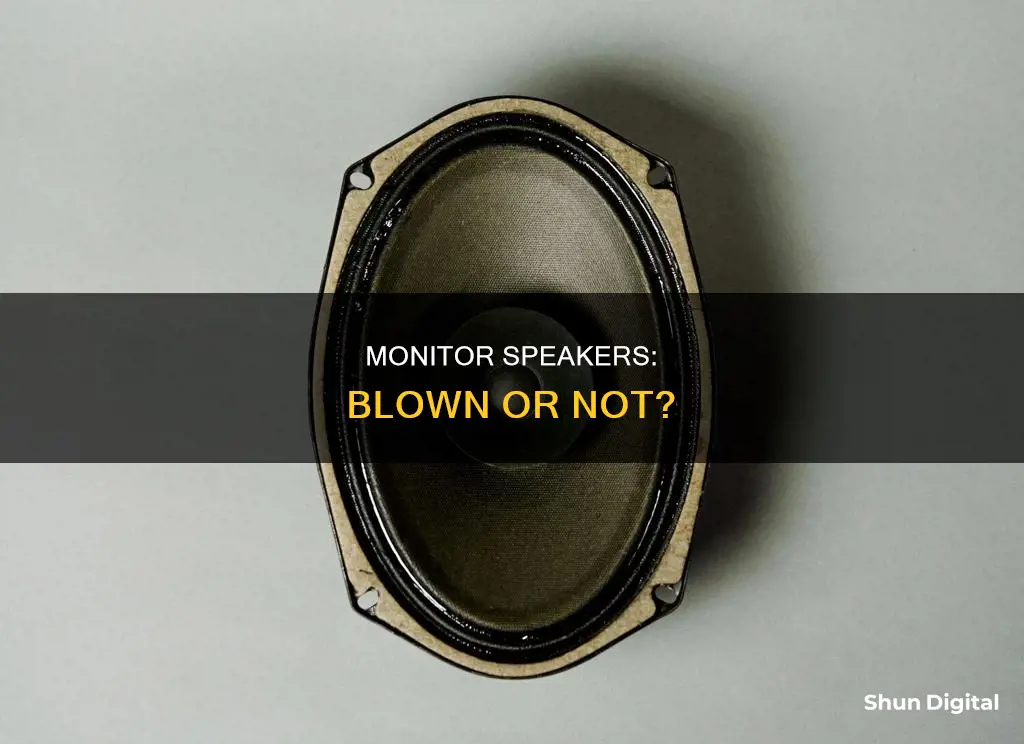
Monitor speakers can become defective due to improper use, with the term 'blown' specifically referring to damage that's been caused by electrical damage which has then caused physical damage during use. This can be identified by a reduction in audio quality, with the sound becoming distorted, fuzzy, or exhibiting hissing, buzzing, or scratching sounds. Alternatively, a blown speaker may not emit any sound at all. To test if your monitor speakers are blown, you can try using a 9-volt battery by touching its terminals to the speaker terminals. If you hear a light 'pop' as the speaker receives some power, your speakers are likely functioning correctly.
| Characteristics | Values |
|---|---|
| Sound | Irritating buzzing, noticeable scratching sounds, or no sound at all |
| Problem | Damage to the cone or the voice coils |
| Indications | Distortion, fuzz, or hiss sounds and the absence of vibration |
| Testing | Using a 9-volt battery, if no sound is produced, the speaker is blown |
| Cause | Physical damage, internal damage, or amplifier issues |
| Prevention | Ensure good quality audio source, avoid excessive volume, and avoid EQ limits |
What You'll Learn
- A blown speaker may be mute or produce buzzing, hissing, or scratching sounds
- Physical damage can be the cause, such as harsh drops or internal damage
- Amplifiers can cause speakers to blow due to overloading power
- Incorrect equalization can lead to improper frequencies and damage speakers
- Audio clipping can occur when speakers are forced beyond their limits, causing distortion

A blown speaker may be mute or produce buzzing, hissing, or scratching sounds
A blown speaker is defective due to improper use, specifically electrical damage that has caused physical damage. This can manifest in several ways, including a complete absence of sound or various unpleasant sounds.
If your speaker is blown, you may not hear anything at all. Alternatively, you may hear a buzzing or hissing sound, or a scratching or scraping noise as the speaker plays. This is caused by the voice coil rubbing against the speaker magnet due to the varnish coating melting from overheating.
If you hear any of these sounds, or a combination of them, it is likely that your speaker is blown.
To test if your speaker is blown, you can try the following:
- Check for distortion, fuzz, or hissing sounds, as well as a lack of vibration. Place your hand above the speaker and compare it to its previous state.
- Use a 9-volt battery. Disconnect the speaker and attach the 9-volt wire. If you hear a popping noise, the speaker is functioning properly. If there is no sound, the speaker is likely blown.
- Inspect the speaker for physical damage. Remove the speaker from its cover and check the cone for any tears or damage.
Monitoring Home Electricity Usage: A Guide for Indian Households
You may want to see also

Physical damage can be the cause, such as harsh drops or internal damage
Physical damage can be the cause of blown monitor speakers. This can be caused by harsh drops, internal damage, or a combination of both. For example, when speakers are dropped, the components inside can weaken over time, leading to a "blown" state. This type of physical damage can also occur when speakers are mishandled during transport or accidentally knocked over.
Internal damage can also be a result of physical impact, such as when the speaker's voice coils cannot withstand certain frequency levels. This can cause the speaker to produce buzzing sounds or sound coloration at different frequencies. Additionally, physical damage can lead to incorrect cone movement, tears in the speaker cone, or improper vibrations, resulting in poor sound quality.
In some cases, the physical damage may not be easily visible. For instance, the voice coil could be damaged, which is typically located inside the speaker and may not be seen from the outside. However, you can perform a simple test by removing the speaker cover and examining the cone and voice coil for any signs of damage.
To prevent physical damage, it is important to handle the speakers with care and avoid dropping or knocking them over. It is also recommended to check the speaker's connections and wiring to ensure there are no loose parts that could lead to internal damage. Proper storage and handling of the speakers can help reduce the risk of physical damage and extend their lifespan.
If you suspect physical damage to your monitor speakers, it is best to consult a professional technician for repair or replacement. While some minor repairs can be attempted at home, more significant physical damage may require specialised tools and knowledge to fix effectively.
Monitoring Bandwidth Usage: PRTG's Per-IP Address Insights
You may want to see also

Amplifiers can cause speakers to blow due to overloading power
In some cases, the amplifier may shut down or blow a fuse to protect itself from excessive power. However, if this happens repeatedly, the amplifier may fail and require repairs. It is important to refer to the owner's manual for the minimum recommended impedance for your amplifier and adjust the settings accordingly.
The voice coil in the speaker can become overworked and heat up beyond its designed capacity. This excess heat can melt the coil's varnish coating, causing it to deform and rub against the speaker magnet, resulting in a rubbing or scraping sound. In other cases, the heat can detach the voice coil from the flexible alignment material, leading to a complete loss of sound.
Additionally, the amplifier may be sending a distorted signal to the speaker, causing the voice coil to become overwhelmed. This distorted signal can be the result of excessive clipping, where the gain or bass controls on the amplifier are set too high for the incoming signal.
To prevent this issue, it is crucial to monitor volume levels and ensure they are within safe limits. Distortion, muddy, or gritty sounds are warning signs that the volume may need to be lowered. It is also important to ensure that the amplifier and speakers are properly matched in terms of impedance and sensitivity to avoid overloading the speakers with too much power.
Monitoring Electricity Usage: Room-by-Room Power Insights
You may want to see also

Incorrect equalization can lead to improper frequencies and damage speakers
Equalization, or EQ, is a common audio processing tool in music production. It allows users to adjust the volume of a frequency or range of frequencies within a sound. This can be done by cutting unwanted frequencies and/or boosting others to balance out sounds so they complement each other.
While EQ is a useful tool, incorrect equalization can lead to improper frequencies and damage speakers. Here's how:
Extreme EQ Boosts
When adjusting the lowest to highest frequencies that the human ear can hear, it is important to do so carefully. While EQ itself will not damage speakers, extreme EQ boosts can cause issues, especially with low-quality headphones or monitors. This can result in a distorted sound, leading to a poor listening experience.
Volume and Gain
The main culprits for speaker damage are high volumes and excessive gain. When using EQ, it is easy to unintentionally increase the overall volume of the mix. If the volume is already high, continually boosting certain frequencies through EQ can cause problems. Additionally, boosting the gain of the EQ can also lead to excessive volume, potentially damaging speakers.
Clipping
Clipping occurs when an audio signal exceeds its capacity, resulting in a distorted or clipped sound. While clipping is usually caused by recording a track too loudly, it can also happen when boosting too much of a particular frequency. This can lead to digital distortion and potentially damage speakers.
Mismatched Equipment
Using an amplifier that is not properly matched to your speakers can also cause issues. An amplifier that is too powerful for your speakers can lead to physical breakdown, while an underpowered amplifier may clip its signal due to the output stage being driven too hard, causing similar issues to those caused by excessive volume.
To avoid improper frequencies and potential speaker damage, it is important to use EQ responsibly, avoid excessive volume and gain levels, and ensure your equipment is properly matched and of sufficient quality.
Choosing the Right Monitor Size for Competitive CS:GO
You may want to see also

Audio clipping can occur when speakers are forced beyond their limits, causing distortion
Audio clipping can occur when a speaker is forced beyond its limits, causing distortion. This is often due to an amplifier that is too powerful for the speaker, resulting in physical damage to the speaker's components. The speaker cone, its rolled surround, and its suspension are usually made of paper or polypropylene materials glued together, and they have limits on the forces they can endure. When these limits are exceeded, one of the components will either rip or come unglued, causing audio clipping.
Additionally, improper equalization can also lead to audio clipping. Equalization (EQ) is the process of adjusting the various balances in your audio signal, such as boosting or removing certain frequencies. However, if EQ settings are adjusted incorrectly, the speakers and circuit may be exposed to levels they are not designed to handle, leading to potential damage.
Furthermore, a low-powered amplifier can also cause clipping. While it may not have enough power to physically damage the speaker, it can still clip the audio signal if the output stage is driven too hard. This distorted signal will then melt the speaker's voice coil, leading to audio clipping and potential speaker failure.
To prevent audio clipping and potential speaker damage, it is important to ensure that the amplifier is appropriately matched to the speaker's power handling capabilities. It is also crucial to avoid excessive volume levels and to adjust EQ settings carefully, always being mindful of potential distortion or other signs of improper usage.
By understanding the causes of audio clipping and taking preventive measures, you can help ensure that your speakers operate within their designed limits, reducing the risk of damage and maintaining optimal audio performance.
Employee Monitoring: Ethical or Invasive?
You may want to see also
Frequently asked questions
If your speakers are blown, you will likely hear a distorted, buzzing, or scratching sound. There may also be a lack of bass, treble, or mid-tones, or the speakers may be completely mute. Physical signs of a blown speaker include incorrect cone movement, tears in the speaker cone, or incorrect vibrations.
If your monitor speakers are blown, it is recommended to replace them with new ones, especially if they are not premium or high-end. While it is possible to repair or re-cone speakers, this is not advised unless you are a professional or willing to risk further damage to the speakers.
To prevent your monitor speakers from blowing, ensure that the amplifier volume is not turned up too high for prolonged periods, and that your amplifier and speakers are a good electrical match. Use a high-quality audio source and avoid maxing out the volume on the source device. If you hear distortion, turn down the volume immediately and adjust your gain and EQ settings.







